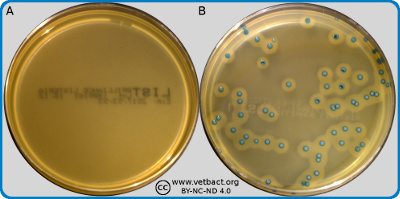Brilliance Listeria agar mediumApplications:Image A shows a plate containing Brilliance™ Listeria Agar before cultivation. Image B shows the same kind of plate on which Listeria monocytogenes has been cultivated at 37°C during 48 hours. Note the unusual colour of the colonies and the turbid zone, which has been formed around these colonies. Click on the image to enlarge (opens in a new window/tab). Image: Karl-Erik Johansson (BVF, SLU) and Lise-Lotte Fernström (BVF, SLU). Brilliance™ Listeria Agar from Oxoid was earlier called Oxoid Chromogenic Listeria Agar (OCLA) and it is a medium used for isolation, enumeration and tentative identification of Listeria spp. and Listeria monocytogenes isolated from food samples. Content of the medium:
The final pH of the medium should be 7.2. The medium should then be mixed with two different supplementary solutions. One solution contains antibiotics (nalidixic acid, polymyxin B, ceftazidime and amphotericin). The other solution contains lecithin. Other comments:Members of the genus Listeria have a β-glucosidase, which cleaves the X-glucoside to a blue-greenish product. Other bacteria, which have a β-glucosidase are inhibited by the antibiotics, which are present in the medium. L. monocytogenes and pathogenic strains of Listeria ivanovii have a lecithinase, which cleaves lecithin to phosphocholine and a diglyceride. The diglyceride is insoluble and if bacteria, which are cultivated on Brilliance Listeria Agar, have a lecithinase, an opalescent zone will be formed around the colonies because of precipitation of the diglyceride. Updated: 2018-05-09. |

